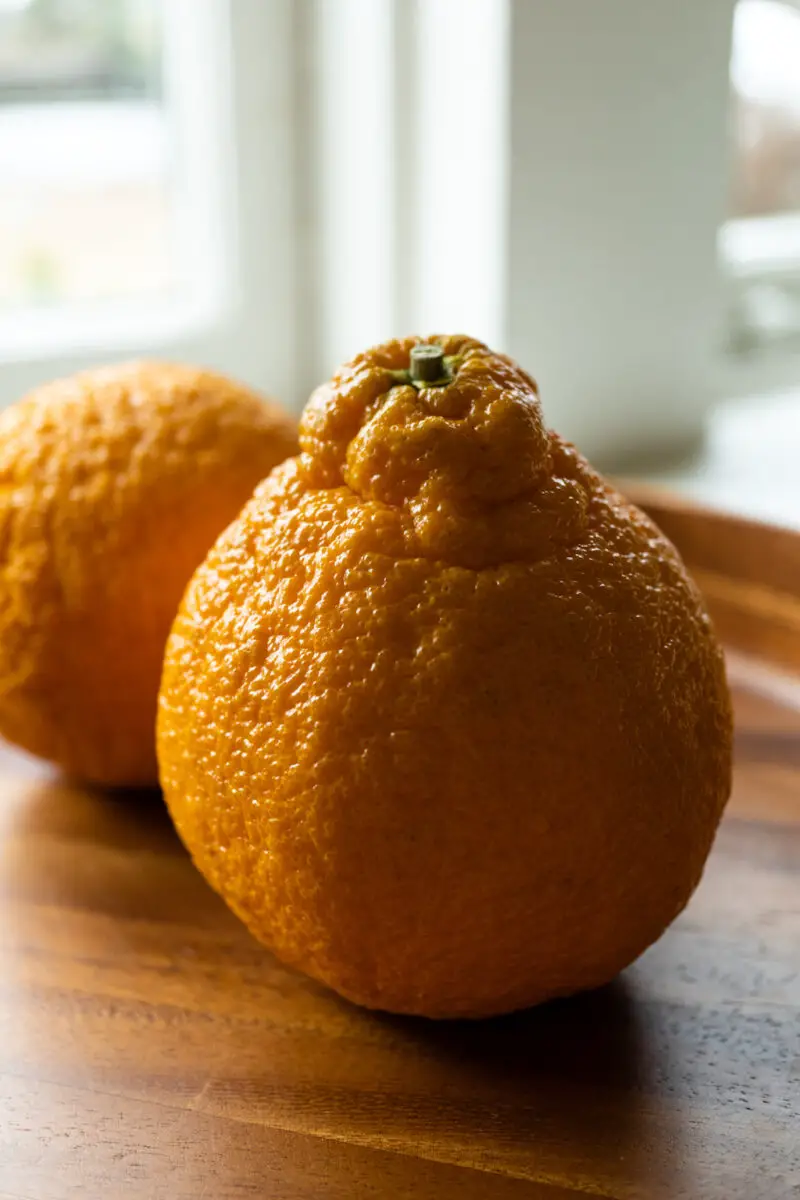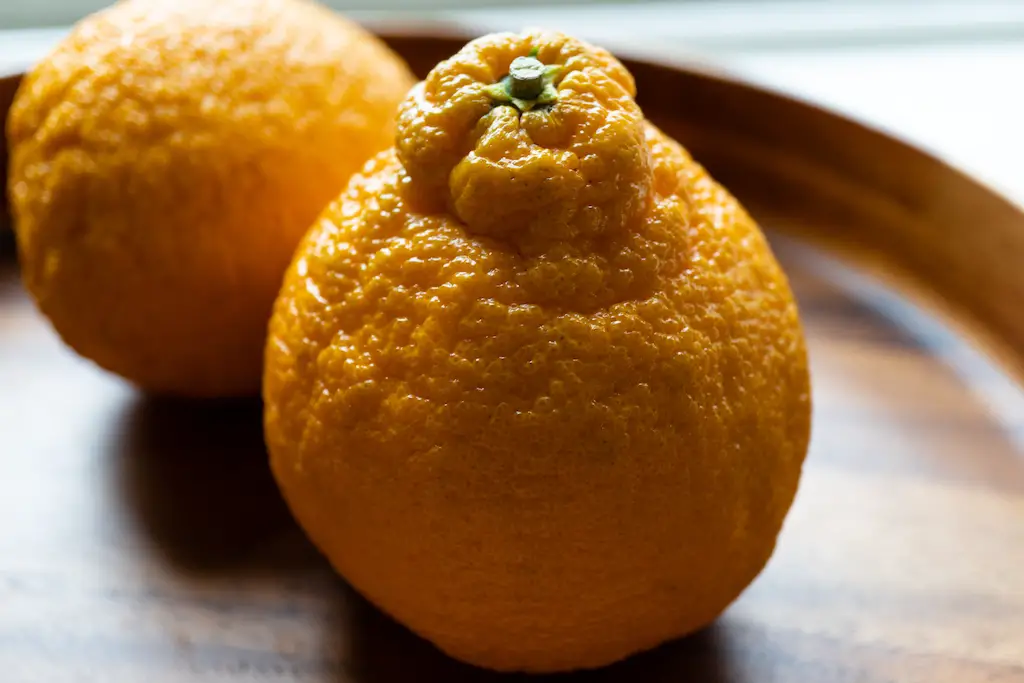This post may contain affiliate links. Please read my disclosure for details at the bottom of this page. As an Amazon Associate, I earn from qualifying purchases on this article about hallabong in Korean cuisine. I hope you enjoy learning about hallabong, a variety of Korean citrus fruit!
What Are Hallabong?
The Korean ‘hallabong’ (한라봉) is a variety of citrus developed by the cross-pollination of the Kiyomi orange and Ponkan tangerine. This hybrid fruit is native to Jeju Island and is now the Island’s representative fruit. These fruits actually get their name from Halla Mountain aka ‘Hallasan’ (한라산), the largest mountain and highest point in South Korea located on Jeju Island.
Though these fruits are considered a tangerine, they look more like standard oranges in size.
While most commonly just peeled and eaten, people also often use this citrus fruit in fancy cafe drinks and sweet desserts! Currently, this fruit hybrid is still mainly grown and eaten in South Korea. If you ever get the chance to eat it while visiting, I definitely recommend trying it!
Note: To learn about more Korean fruits, check out my article on the subject! Or, you can check out the fruit section of my Korean ingredient glossary!
Hallabong in Korean Cuisine:
Once again, people refer to this specialty hybrid fruit as ‘hallabong’ (한라봉). As I stated in the previous section, people typically just peel and eat this fruit. That being said, it is used to make some delicious drinks and desserts (especially in fancy cafes). Below, I list a few ways people use this fruit:
- Hallabong-Cha (한라봉차): In English, we can translate this to ‘hallabong tea.’ Typically, people in Korea make this tea by making marmalade out of sugar and this citrus fruit. Then, they mix the marmalade with hot water!
- Hallabong Bingsu (한라봉 빙수): We can translate this dish to ‘hallabong shaved ice!’ In South Korea, people make shaved ice using milk and sweetened condensed milk. They then top the ice with sweet ingredients, such as hallabong puree!
The people of Jeju also sell specialty edible hallabong items such as juice or citrus-covered chocolates! Not only that, you can get skincare products, scented candles, and more made using this fruit as well. Obviously, Jeju Island is very proud of its representative fruit!
Hallabong Frequently Asked Questions:
Now that we learned about this Korean citrus fruit, I want to answer some questions you may have about it as well! If I do not answer your question, feel free to leave a comment in the section below or email me at [email protected].
What Does Hallabong Taste Like?
This fruit has a high sugar content which lends to an intensely sweet and slightly sour flavor.
The ripe fruit has a soft and juicy texture.
On a personal note, I still cannot get over this citrus even after a few years since moving back to the United States from South Korea. My husband laments that the citrus doesn’t taste nearly as good in America as in his home country.

Where Can I Buy This Ingredient?
Unfortunately, you will not find this ingredient in your typical (western) grocery store. Thankfully, you can sometimes find this fruit at your local Korean or Asian grocery store during the winter. Further, you can sometimes find this fruit for sale online via vendors.
If you cannot find this fruit, you may just have to visit South Korea during the winter and early Spring! These fruits are worth it!
Note: Farmers have started growing these fruits in California. At this point, you may be able to find hallabong at Whole Foods. At Whole Foods, it is typically labelled as a ‘Dekopon,’ the Japanese term for this fruit. Hopefully, they become more popular and will be sold in other grocery store chains as well!
How Do I Properly Store Hallabong?
Citrus (such as hallabong, oranges, tangerines, and lemons) can be stored short-term at room temperature. To keep these fruits for a prolonged period, keep them in a bag in the refrigerator. If properly stored, citrus can last in the refrigerator for a month!
What Is a Good Fruit Substitute?
If you cannot find Korean hallabong, I recommend just eating a tangerine. While not nearly as sweet, regular tangerines are also yummy!
I Hope You Enjoyed Learning About Hallabong!
In the end, I hope you enjoyed learning about the uses of hallabong in Korean cuisine. If so, let me know in the comment section!
If you would like to read more about cooking, you can find recipes as well as further Korean ingredient articles on my blog. I listed some of our favorite Carving A Journey recipes below! For reference, many recipes are influenced by my family’s blended Korean and Southern heritage.
Korean Ingredient Articles:
- Lotus Roots (Yeongeun)
- Korean Dried Radish Strips (Mumallaengi)
- Dried Kelp (Dashima)
- Dried Persimmon (Gotgam)
- Korean Pepper (Gochu)
- Garlic Chives (Buchu)
Further Carving A Journey Recipes:
- Korean Clam Soup (Jogaetang)
- Gyeran Bap (Korean Egg Rice Recipe)
- Korean Egg Soup (Gyeran Guk)
- Korean Anchovy Broth (Myeolchi Yuksu)
- Korean Acorn Jelly Salad (Dotorimuk-Muchim)
- Korean Acorn Jelly (Dotorimuk)
If you have any questions or comments, you can also email me at [email protected]. And, finally, I would love to hear from you through our social media as well! You can follow me at @carvingajourney on Instagram, Facebook, and Pinterest. I also started a vlog Youtube channel with my husband! Or, if you would like more articles like these, you can subscribe to the blog by joining the mailing list. Let me know if you try eating hallabong! Thank you so much for stopping by!
Carving A Journey is a participant in the Amazon Services LLC Associates Program, an affiliate advertising program designed to provide a means for sites to earn advertising fees by advertising and linking to Amazon.com. Although we may earn commissions for our endorsement, recommendation, testimonial, and/or link to any products or services from this website, these opinions are my own and I fully support these products.


4 comments
Emily –
So delighted to find your site and learn about this delicious fruit, which we just discovered, during our brief Korean sojurn.
By mid-March in Korea, the tangerines had disappeared from grocery & market shelves. Missing my favorite fruit, we hoped maybe the E-Mart, on the lowest level of the amazing Starfield Mall at Pyongtaek, might still have some stock.
No luck for tangerines. “Hallabong” and “Jeju” were the only English words on the sign, over these large, orange, citrus fruits. They looked enough like tangerines, and they were “local”, that I persuaded the doubtful husband to try a box of six. Oh my goodness! How will I settle for tangerines again? We need another trip to E-Mart to stock up, before hallabong season ends too.
They are so delicious fresh. But hallabong-cha sounds tempting. If it is to be made into marmalade, then some of the rind should be included too, no? I might try a little made with honey.
Thanks for this site, which is both interesting and useful.
Hi! I am so glad this article helped you out! Aren’t they delicious?! To make into marmalade, I would definitely include some of the rind. Thank you for the comment!!!
Emily 🥰 I love everything I’ve just read up on the hallabong! My favorite western fruit is the tangerine!
I look forward to trying the hallabong-cha and hallabong bingsu! (Should those two descriptions be in capital letters?)
I will try either While Foods, KanMan grocery or Amazon to get the fruit.
Thank you!
Debbie
Hi Debbie! Thank you for the comment! If you find hallabong at Whole Foods let me know! It can be hit-or-miss.
No need to capitalize the two descriptions 🥰! If you do find them and make some recipes, let me know and send me pictures via email or Facebook!